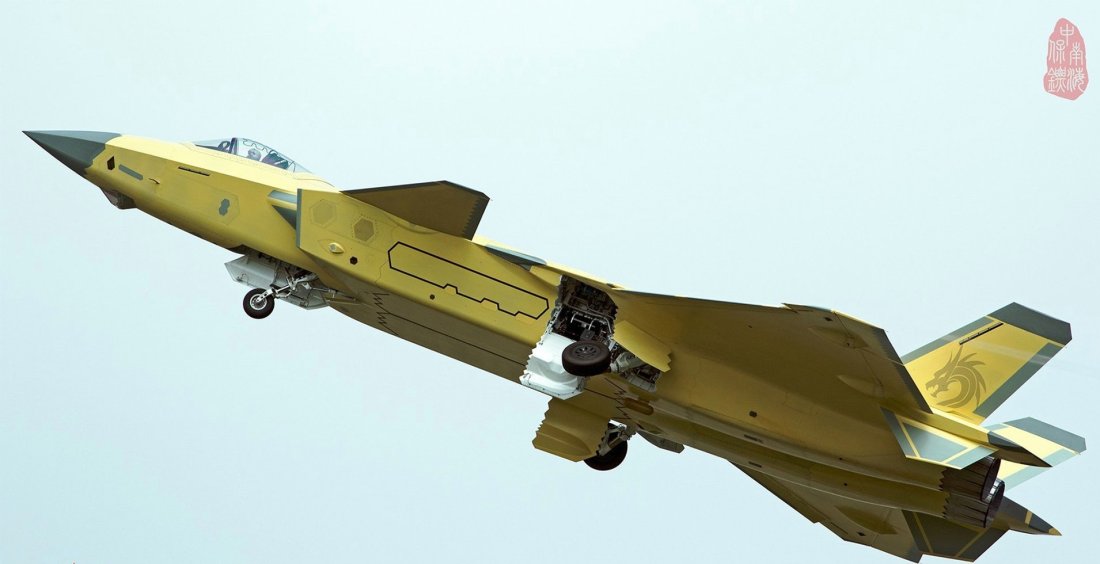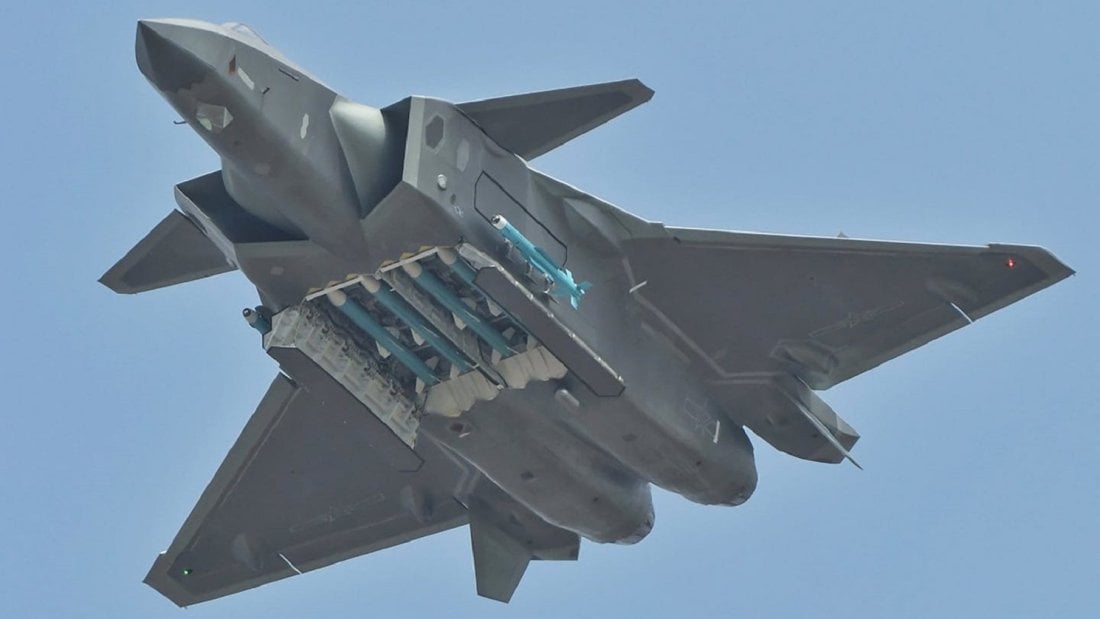- Joined
- Sep 22, 2008
- Messages
- 79,849
- Points
- 113
The National InterestOpen Menu

May 27, 2019 Topic: Security Blog Brand: The Buzz Tags: ChinaJ-20Stealth FighterStealthPLAAF
We Have Close-Up Pictures of China's J-20 Stealth Fighter: What They Mean
What do you think?
by Task and Purpose
Although the J-20 has been pushed into service, recent problems with the J-15 carrier-based fighter suggest that the Chinese answer to the F-22 isn’t quite ready for prime-time despite propaganda from Chinese-owned media outlets that portray the J-20 as a fully-armed and operational battle station. That certainly sounds familiar …
On August 1st, China celebrated the founding of the People's Liberation Army by allowing some high-resolution photos of the next-generation J-20 stealth fighter to leak, complete with a tasteful photoshopped-on patriotic dragon painting just below the canopy which just screams "Happy Birthday, PLA."





dafeng cao@dafengcao
https://twitter.com/dafengcao/status/1024227912235413505
As usual, photos of J-20 are posted online to celebrate the Army Day on 1 Aug.
207
5:38 PM - Jul 31, 2018
114 people are talking about this
Twitter Ads info and privacy
(This article originally appeared at Task & Purpose. Follow Task & Purpose onTwitter. This article first appeared in 2018.)
Report Advertisement
The new photos of the J-20 provide an up close and personal look at the fuselage of the new interceptor. But the photos also appear to show a sensor system that looks awfully similar to the Lockheed Martin Electro-Optical Targeting System (EOTS) on the front of the F-35 Lighting II.
There’s a reason for this: In 2007, Lockheed Martin dealt with something of a cyber Ocean’s 11 when Chinese hackers stole technical documents related to the development of the F-35. The details on the hack, eventually revealed in documents leaked by Edward Snowden, are just one example of Chinese attempts to steal foreign aviation technology; as recently as 2017, Chinese hackers went after Australian F-35 defense contractors, nabbing even more info on the cutting-edge fighter.
Report Advertisement
Although the two electro-optical systems pictured above are not identical, they share quite a few similarities in shape and placement: compared to the Eurofighter or Su-57’s electro-optical systems and Infrared Tracking Systems (IRTS), respectively, which are also mounted on top of the fuselage, the differences between the Lockheed Martin and J-20’s Systems ate relatively minor. The system’s positioning under the nose of the aircraft also reinforces that the J-20 is probably designed for both long-range strike missions against ground targets and interceptor duties. However the J-20 EOTS appears to be less capable than the F-35 equivalent, judging by the size and layout of the J-20 EOTS enclosure.
Much about the J-20 is shrouded in secrecy, but the plane is most likely powered by the same two AL-31F engines which are used in the Su-27, a Russian fighter that is capable of a top speed of Mach 2.3. But the J-20 could also be flying with indigenous (but less reliable) WS-10B engines, due to a lack of Russian engines or as a stopgap until the more powerful WS-15 jet engines are ready for operational use. And while parts of the design of the J-20 appear to resemble the F-22 and it’s stealthy curves, these similarities could be skin deep as the angularity on the jet inlets and wings remain quite different, and the J-20 lacks all-aspect stealth. Recently the Indian Air Force claimed they could track the J-20 using the Su-30MKIs electronically scanned ‘Phazotron Zhuk-AE’ radar.
Although the J-20 has been pushed into service, recent problems with the J-15 carrier-based fighter suggest that the Chinese answer to the F-22 isn’t quite ready for prime-time despite propaganda from Chinese-owned media outlets that portray the J-20 as a fully-armed and operational battle station. That certainly sounds familiar …

May 27, 2019 Topic: Security Blog Brand: The Buzz Tags: ChinaJ-20Stealth FighterStealthPLAAF
We Have Close-Up Pictures of China's J-20 Stealth Fighter: What They Mean
What do you think?
by Task and Purpose
Although the J-20 has been pushed into service, recent problems with the J-15 carrier-based fighter suggest that the Chinese answer to the F-22 isn’t quite ready for prime-time despite propaganda from Chinese-owned media outlets that portray the J-20 as a fully-armed and operational battle station. That certainly sounds familiar …
On August 1st, China celebrated the founding of the People's Liberation Army by allowing some high-resolution photos of the next-generation J-20 stealth fighter to leak, complete with a tasteful photoshopped-on patriotic dragon painting just below the canopy which just screams "Happy Birthday, PLA."





dafeng cao@dafengcao
https://twitter.com/dafengcao/status/1024227912235413505
As usual, photos of J-20 are posted online to celebrate the Army Day on 1 Aug.
207
5:38 PM - Jul 31, 2018
114 people are talking about this
Twitter Ads info and privacy
(This article originally appeared at Task & Purpose. Follow Task & Purpose onTwitter. This article first appeared in 2018.)
Report Advertisement
The new photos of the J-20 provide an up close and personal look at the fuselage of the new interceptor. But the photos also appear to show a sensor system that looks awfully similar to the Lockheed Martin Electro-Optical Targeting System (EOTS) on the front of the F-35 Lighting II.
There’s a reason for this: In 2007, Lockheed Martin dealt with something of a cyber Ocean’s 11 when Chinese hackers stole technical documents related to the development of the F-35. The details on the hack, eventually revealed in documents leaked by Edward Snowden, are just one example of Chinese attempts to steal foreign aviation technology; as recently as 2017, Chinese hackers went after Australian F-35 defense contractors, nabbing even more info on the cutting-edge fighter.
Report Advertisement
Although the two electro-optical systems pictured above are not identical, they share quite a few similarities in shape and placement: compared to the Eurofighter or Su-57’s electro-optical systems and Infrared Tracking Systems (IRTS), respectively, which are also mounted on top of the fuselage, the differences between the Lockheed Martin and J-20’s Systems ate relatively minor. The system’s positioning under the nose of the aircraft also reinforces that the J-20 is probably designed for both long-range strike missions against ground targets and interceptor duties. However the J-20 EOTS appears to be less capable than the F-35 equivalent, judging by the size and layout of the J-20 EOTS enclosure.
Much about the J-20 is shrouded in secrecy, but the plane is most likely powered by the same two AL-31F engines which are used in the Su-27, a Russian fighter that is capable of a top speed of Mach 2.3. But the J-20 could also be flying with indigenous (but less reliable) WS-10B engines, due to a lack of Russian engines or as a stopgap until the more powerful WS-15 jet engines are ready for operational use. And while parts of the design of the J-20 appear to resemble the F-22 and it’s stealthy curves, these similarities could be skin deep as the angularity on the jet inlets and wings remain quite different, and the J-20 lacks all-aspect stealth. Recently the Indian Air Force claimed they could track the J-20 using the Su-30MKIs electronically scanned ‘Phazotron Zhuk-AE’ radar.
Although the J-20 has been pushed into service, recent problems with the J-15 carrier-based fighter suggest that the Chinese answer to the F-22 isn’t quite ready for prime-time despite propaganda from Chinese-owned media outlets that portray the J-20 as a fully-armed and operational battle station. That certainly sounds familiar …



